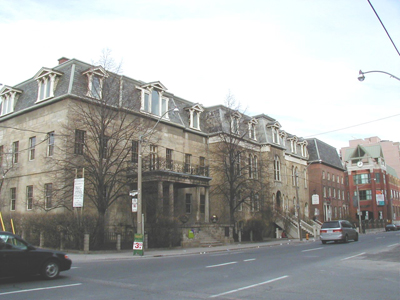Bank of Upper Canada Building National Historic Site of Canada
Toronto, Ontario

Panorama
© Parks Canada Agency / Agence Parcs Canada, 2003.
Address :
252 Adelaide Street East, Toronto, Ontario
Recognition Statute:
Historic Sites and Monuments Act (R.S.C., 1985, c. H-4)
Designation Date:
1977-06-06
Dates:
-
1827 to 1834
(Construction)
Other Name(s):
-
Bank of Upper Canada Building
(Designation Name)
Research Report Number:
1977-18, 1979-27, 1979-29
Plaque(s)
Chartered in 1821, the Bank of Upper Canada was, until its demise in 1866, one of British North America's leading banks. It played a significant role in the development of Upper Canada - - supplying currency, protecting savings and making loans - - and aided Toronto's rise as the commercial centre of the colony. This building, opened in 1827, was the second home of the bank. Its design reflects the image of conservative opulence favoured by financial institutions of the time. The portico, designed by John G. Howard, a leading architect of the period, was added about 1844.
Description of Historic Place
The Bank of Upper Canada building is an early 19th-century, two-and-a-half-storey, Neoclassical stone building. It is located on Adelaide Street in downtown Toronto. The formal recognition consists of the building on its property at the time of recognition.
Heritage Value
The Bank of Upper Canada Building was designated a national historic site in 1977. The reasons for designation are: the role played by the Bank of Upper Canada in the development of Upper Canada and in the rise of Toronto as the commercial centre of the colony and the design of the building, reflecting the image of conservative opulence favoured by financial institutions of the time.
The heritage value of this place resides in its role in Canada's early banking history as reflected in its restrained classicism and enduring materials.
A portico designed by architect John G. Howard and added in 1844 contributes to the restrained classicism of the building.
Source: Historic Sites and Monuments Board of Canada(HSMBC), Minute, November 1979; HSMBC, plaque text, 1984.
Character-Defining Elements
The key elements that relate to the heritage value of this site include: its rectangular massing and mansard roof; the organization of the original structure, with seven bays on the façade and four bays along the sides, creating a broad but compact mass; its stone exterior, with rusticated masonry on the foundation and smooth-dressed stonework on the upper storeys; its projecting three-bay entrance; its Neoclassical portico, consisting of: a raised podium; paired columns; a strongly defined entablature; and a second-storey balcony; the classical detailing of the entrance door, including: the stone arched frame; fluted pilasters on either side; the semi-rounded transom; rectangular sidelights, square-headed jamb; and simple moulded reveal.